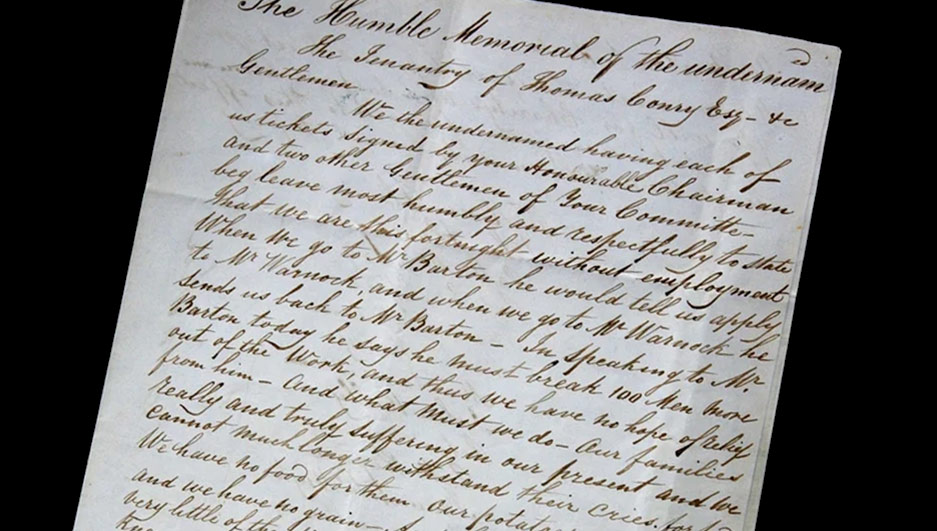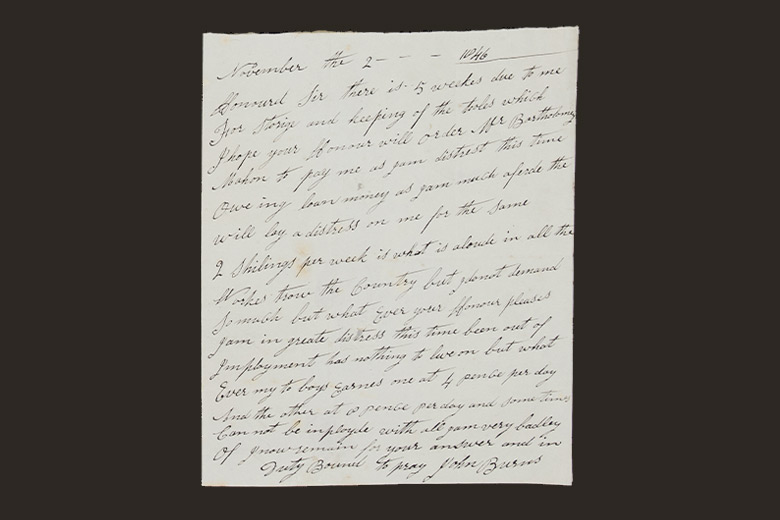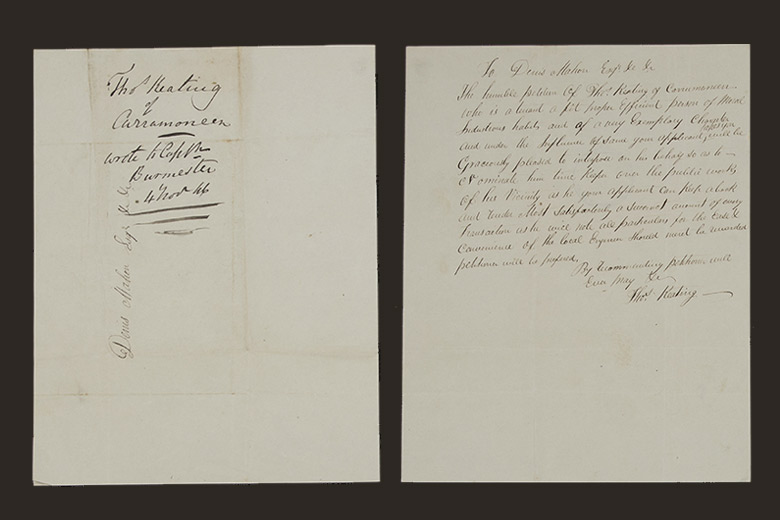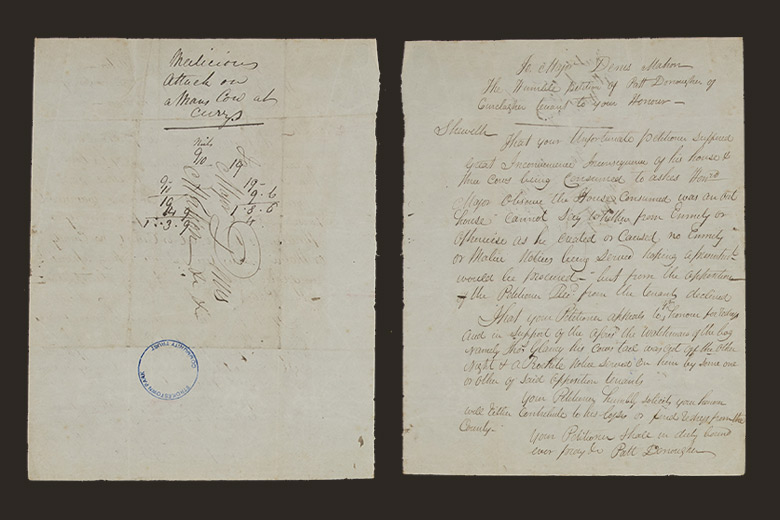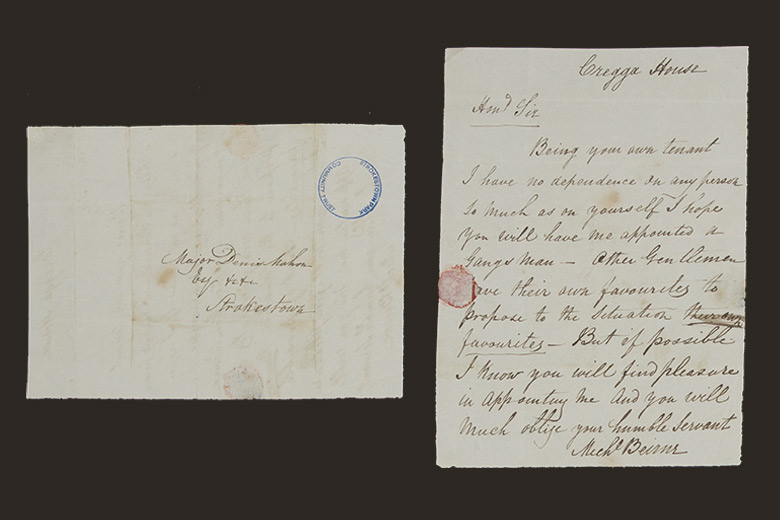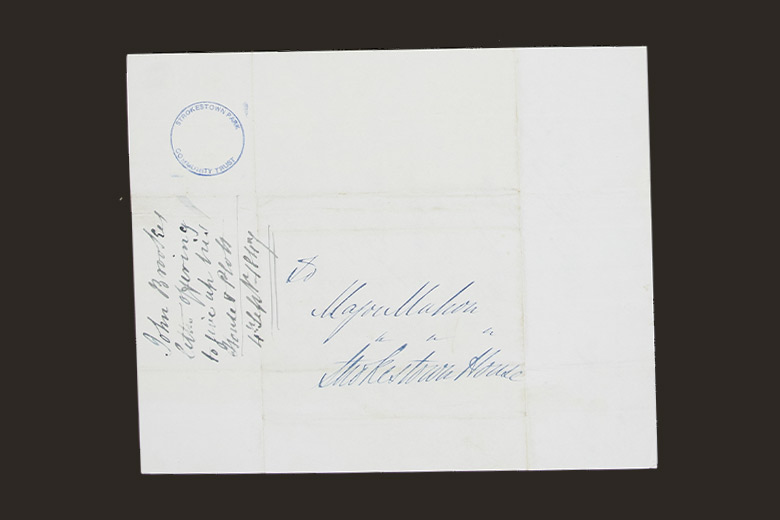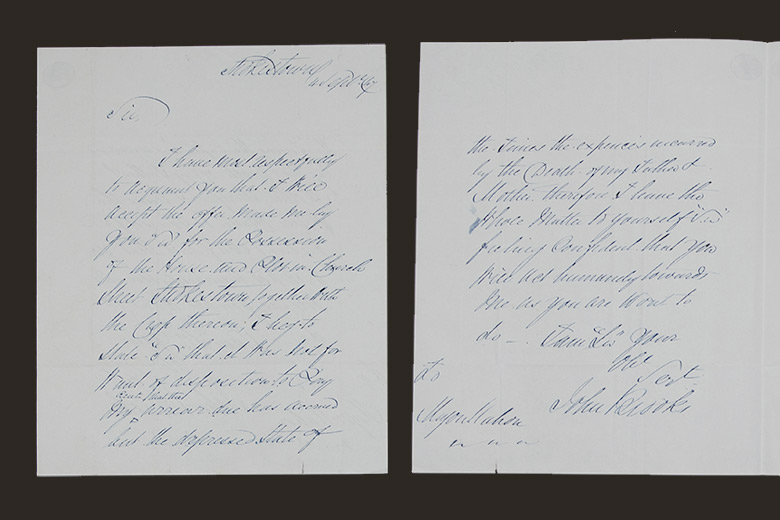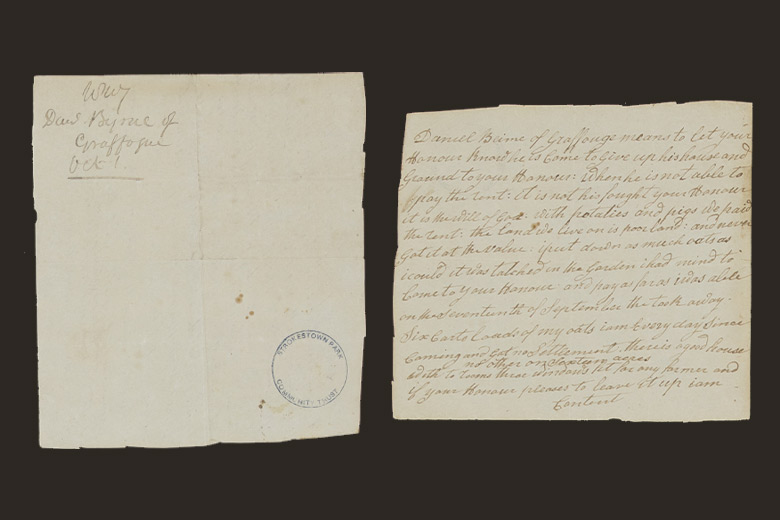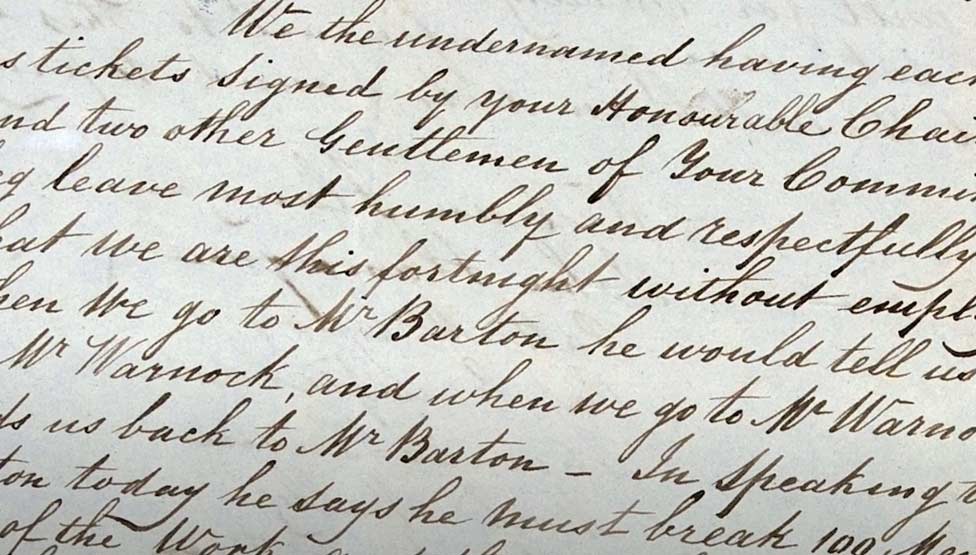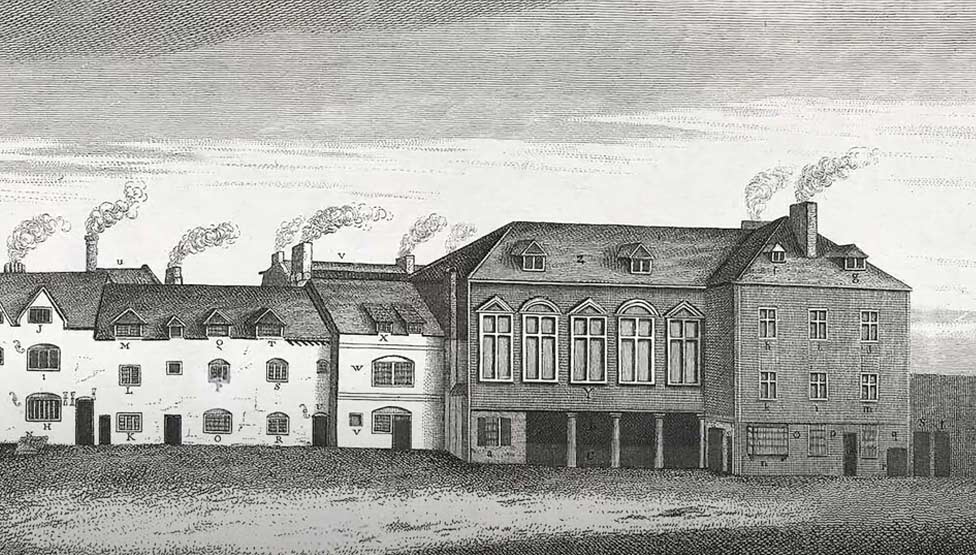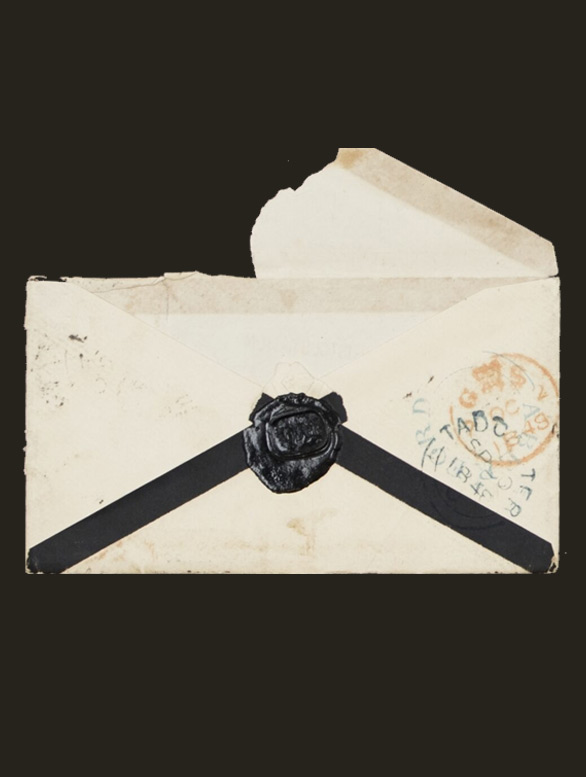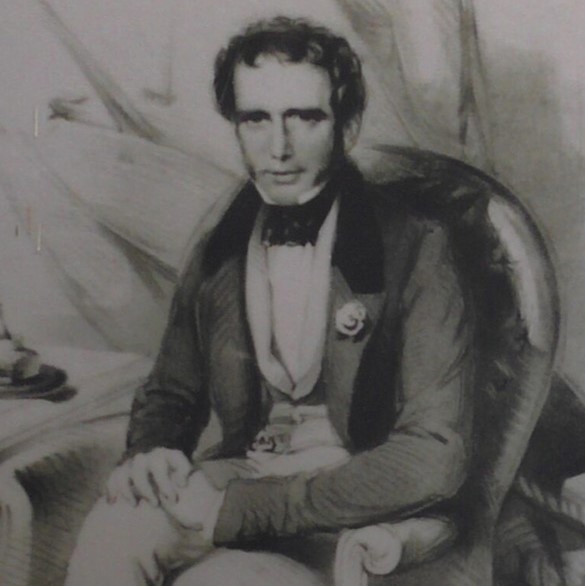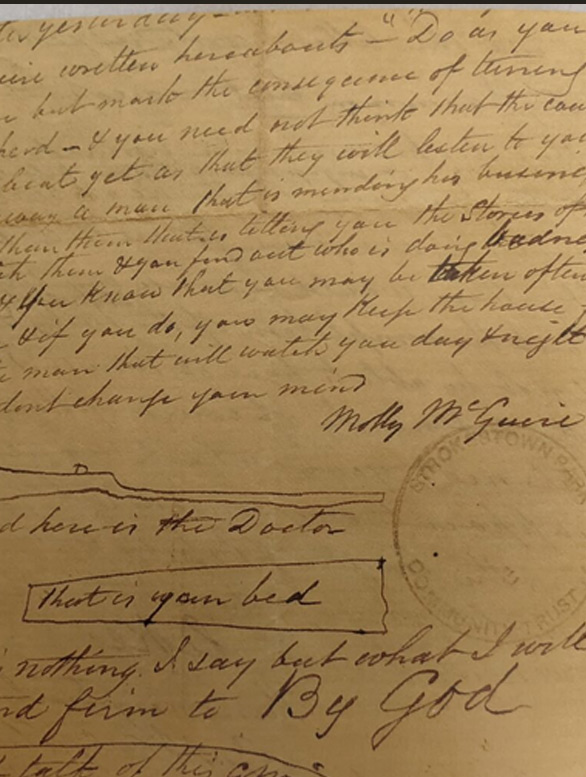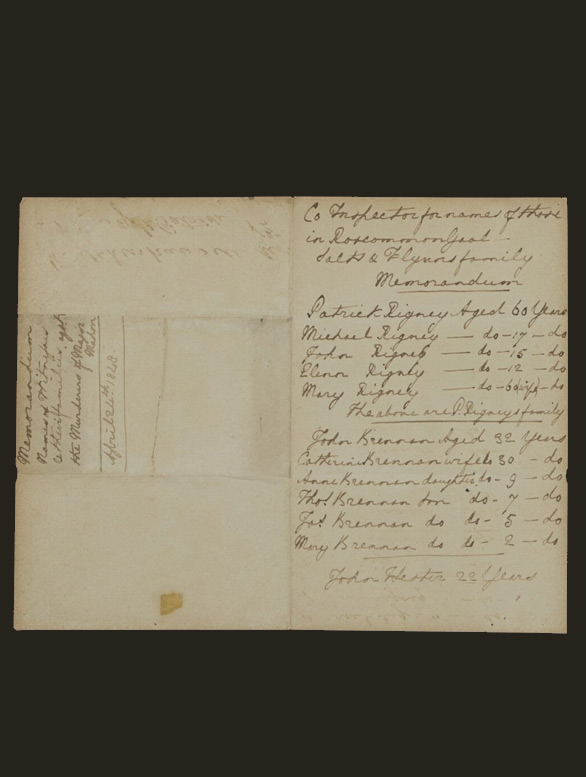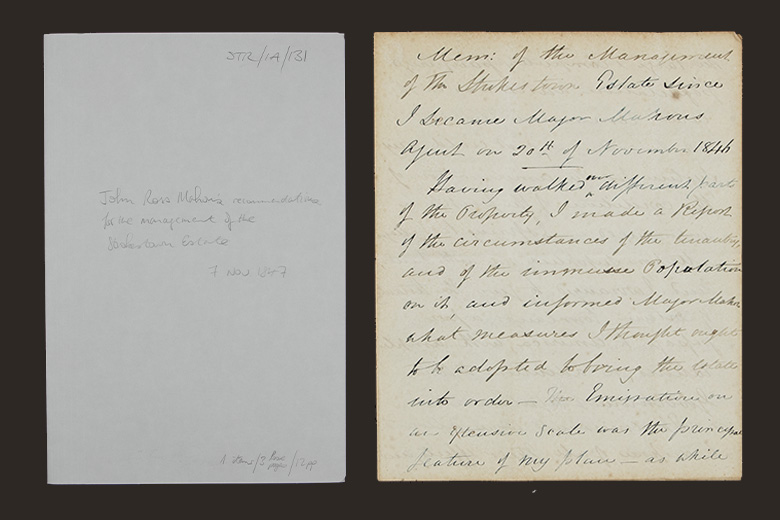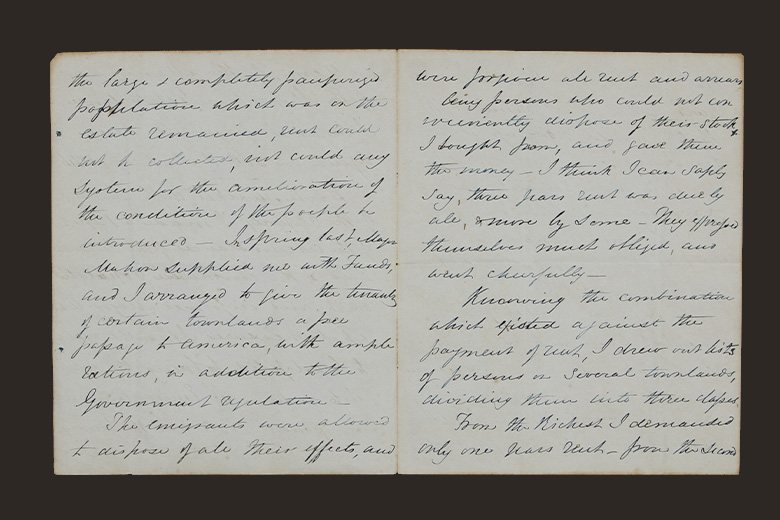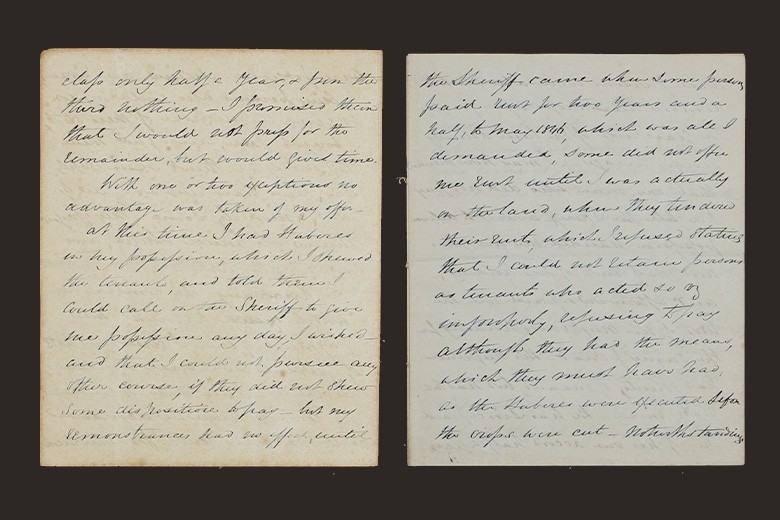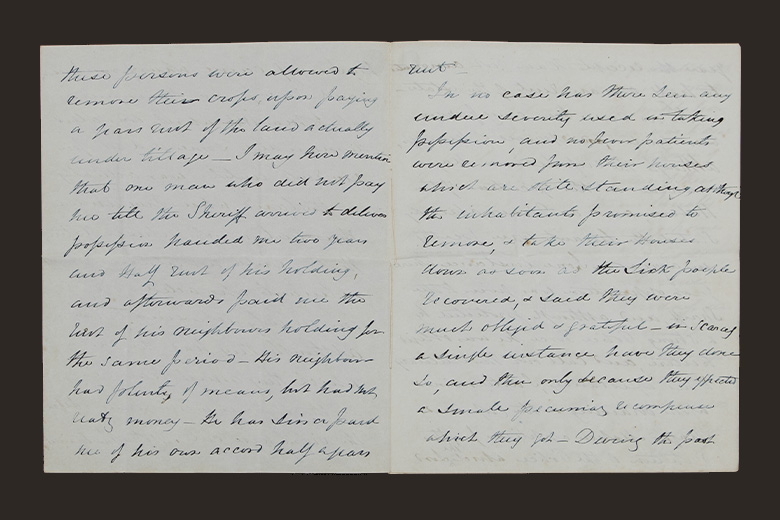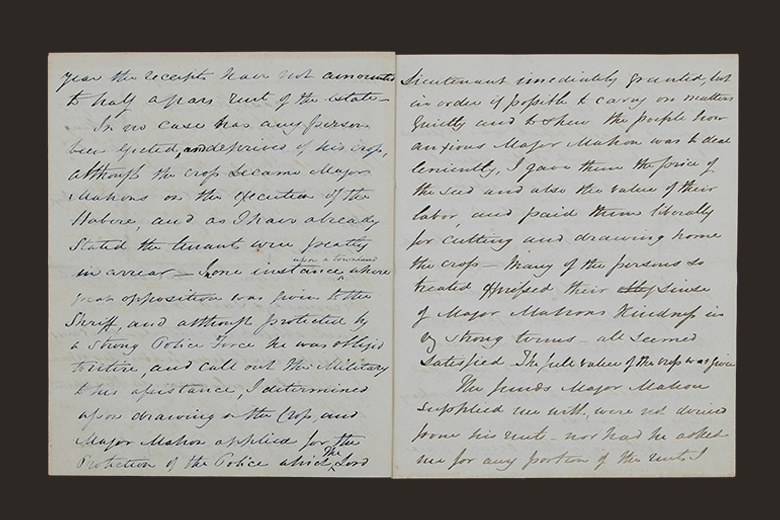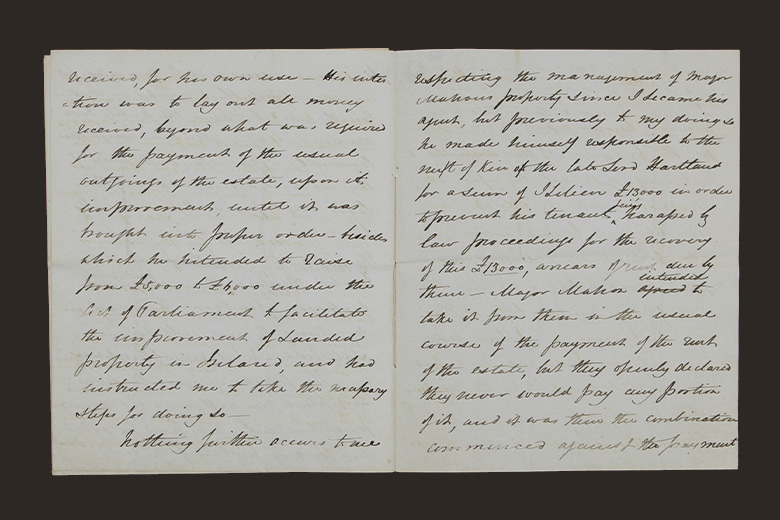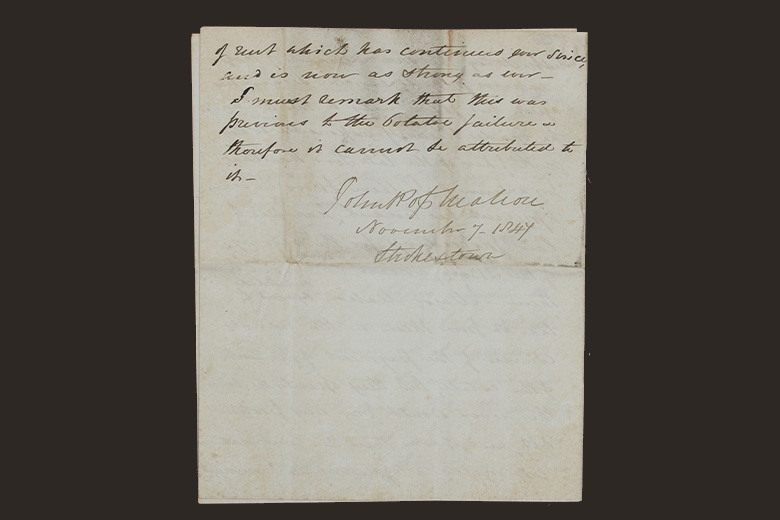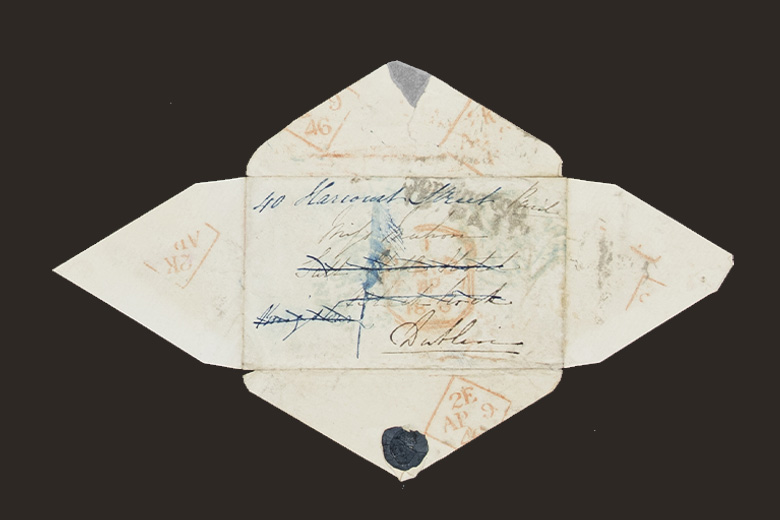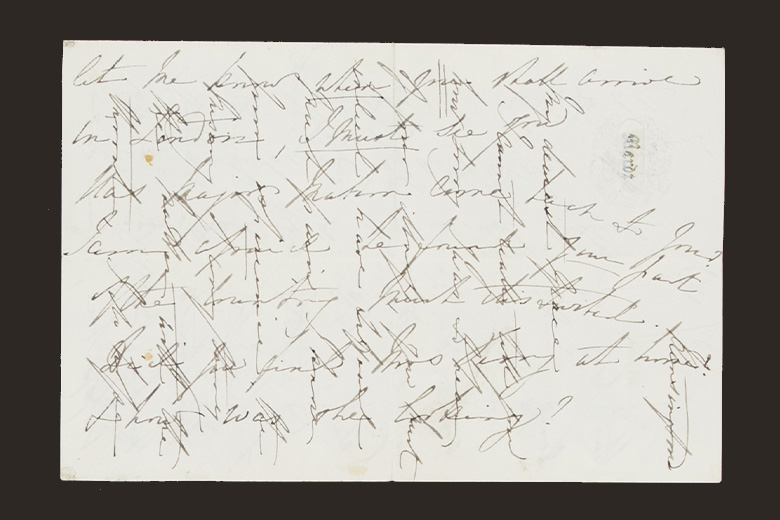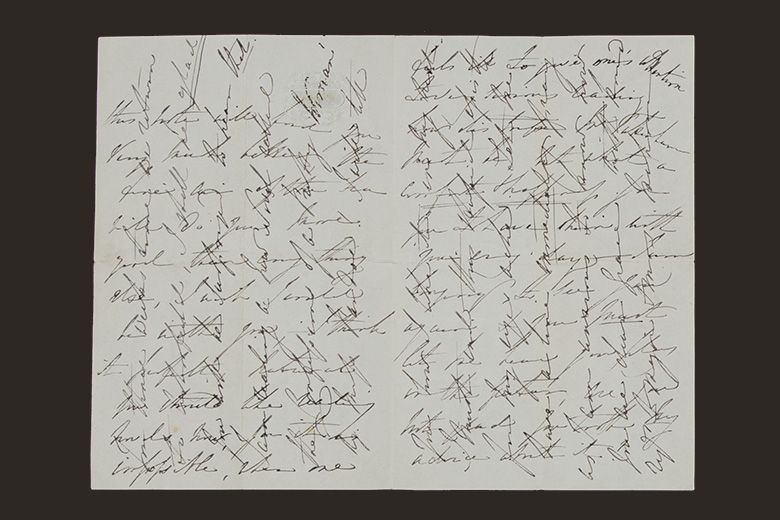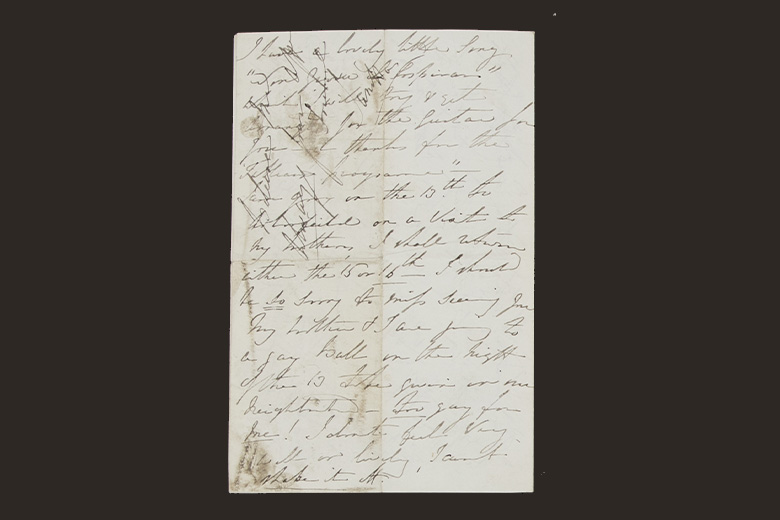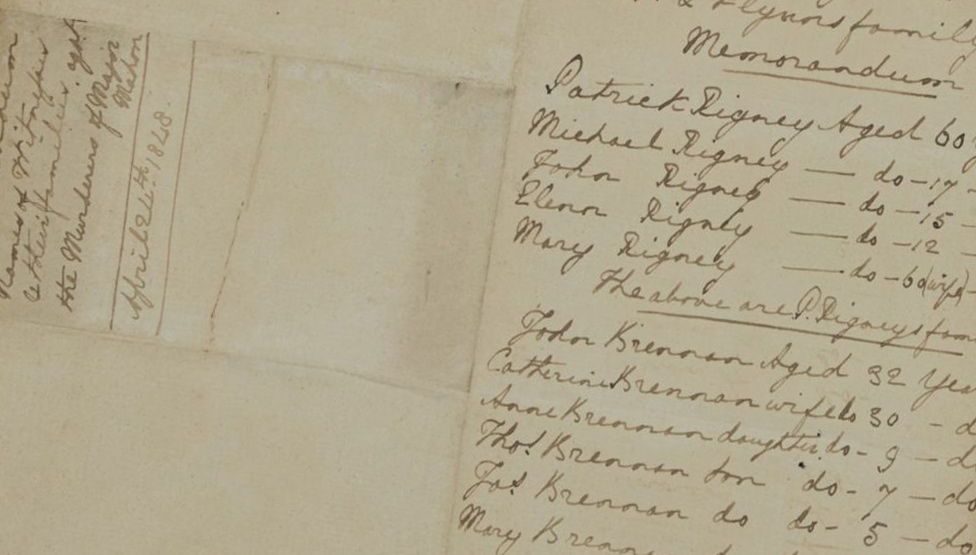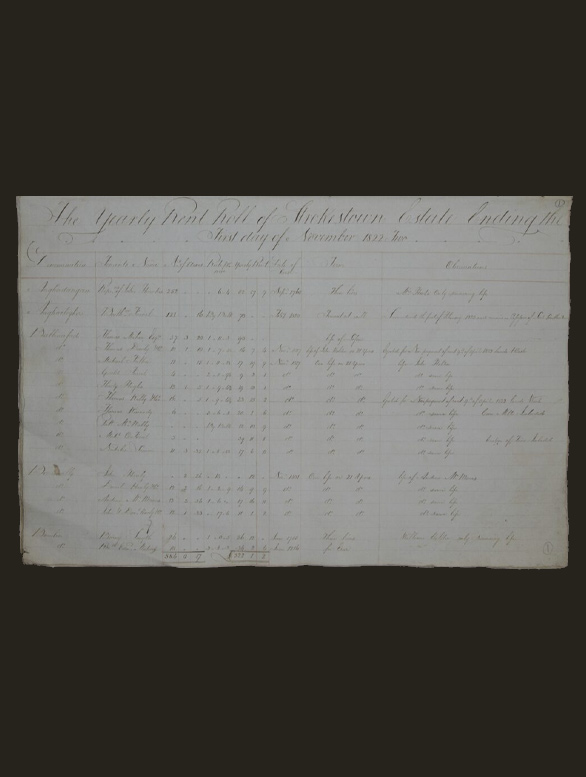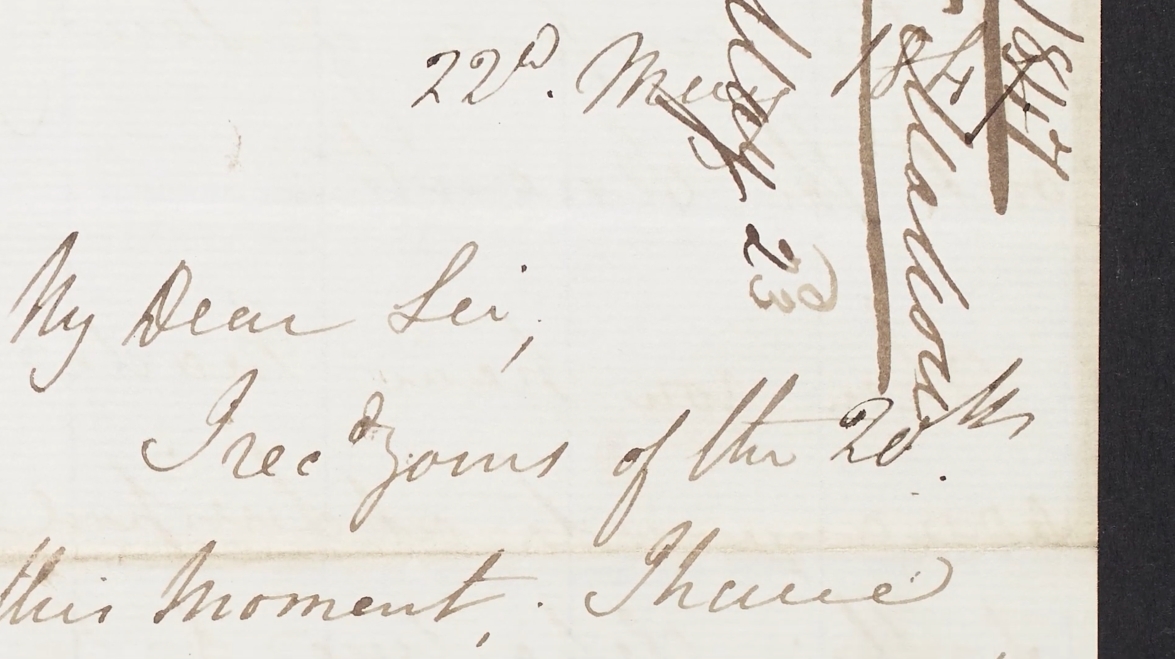The Archive
The Strokestown Park Archive contains thousands of documents related to the Great Irish Famine of the 1840s. It encapsulates the names and stories of the tenants, cottiers and labourers, including the 1,490 men, women and children who were forced to emigrate in 1847. It also features records relating to the assassination of the landlord Major Denis Mahon that same year.
The numerous petitions in the archive give voice to the most destitute and dispossessed. It was the discovery of the Cloonahee Petition by James Callery after purchasing Strokestown Park House that inspired him to create the National Famine Museum. These petitions and other treasures of the Strokestown Park archive are made publicly accessible in this virtual exhibit for the first time. It has been funded by the Heritage Council.
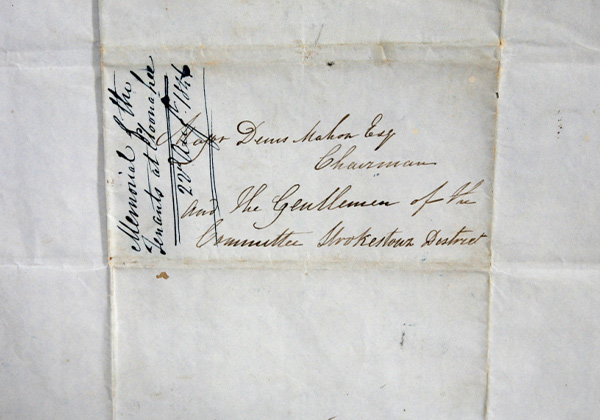
The virtual exhibit is comprised of four key themes and sections.
- 1847 Strokestown emigration scheme of the 1,490 shares the records of tenants from the estate who crossed the Atlantic on some of the worst of the coffin ships as selected by Professor Mark McGowan (University of Toronto).
- Petitions and Voices of the Dispossessed express the plight of the most destitute on the Strokestown Park estate as cottiers and landless labourers sought to forestall hunger and eviction.
- The Assassination of the Landlord, Major Denis Mahon, and Secret Societies as interpreted by Professor Christine Kinealy (Ireland’s Great Hunger Institute, Quinnipiac University).
- Digitized Rental Books and Letters as selected by Strokestown Park Archivist, Martin Fagan.
1847 Strokestown emigration scheme of the 1,490
STR/1A/148 Copy of lists of tenants for an assisted emigration scheme from the Strokestown Estate in April 1847.
These archival records are the jewel of the collection regarding Denis Mahon’s 1847 emigration scheme. It is the record taken by the agent John Ross Mahon and the bailiffs, as they moved from townland to townland, investigating as to whether or not tenants wanted to take up the scheme. That is, have their cabins leveled, be compensated for the crops that they had, have their rents, in a sense, cancelled, in order to take up this scheme to resettle in Canada West.
They also indicate the size of the families, and the kind of debt that they held that would be erased as a result of taking up the scheme. Ultimately, they provide an invaluable record of the names of real people who emigrated from the Strokestown Park estate at the height of the Great Irish Famine in 1847 and the means to help track their movements across the Atlantic and settlement patterns in Canada and the United States.
1847 Strokestown Assisted Emigration Scheme of the 1,490 Video Exhibit
This exhibit shares the records of tenants from the estate who crossed the Atlantic on some of the worst of the coffin ships. They have been selected by Professor Mark McGowan (University of Toronto) who discusses Denis Mahon’s assisted emigration scheme in 1847.
‘Those of the Poorest and Worst Description’
Major Denis Mahon and his agent, John Ross Mahon, were dismayed to discover that ‘many of those applying for the [emigration] scheme were the better sort of tenant and if possible should be kept at home’. As the landlord had written from the United Service Club in London on 14 April 1847, they should seek to remove ‘those of the poorest and worst description who would become a charge on us for Poor House outdoor relief’. You can read the letter to the right and the ‘Transcript of Letter from Major Denis Mahon to John Ross Mahon, 14 April 1847’ here.
The scale of destitution on the Strokestown Park estate was indicated in a census (document 127) undertaken on 21 March 1847. It revealed that the estate’s occupants were spread out over 68 townlands with a population of 12,000 people, including about 2, 237 families. The extreme poverty amongst Denis Mahon’s tenants and subtenants is also reflected in an extensive list of 250 recipients of American corn or maise in 1846 (document 122) that was provided at little or no charge. It was a dietary supplement to replace the potatoes that had been lost during the blight.
Ultimately, thousands were cleared from the estate through assisted emigration and mass evictions, especially after the assassination of Major Denis Mahon in November 1847. The ‘Mem[orandum] of agreement of Tenants on Strokestown Estate’ on giving up possession of their holdings and becoming caretakers; witnessed by Michael Dalton, 14 May 1847’ (document 150) attached provides one of countless examples of their loss of tenancy.
An Emigrant Orphan Voice
During the spring of 1847, approximately one third of the 1,490 assisted emigrants from the Strokestown Park estate perished when they crossed the Atlantic on some of the worst of the coffin ships such as the Virginius and the Naomi and in the fever sheds of Grosse Île quarantine station in Quebec. Only one emigrant orphan named Thomas Quinn left a record of his experience. He was summoned with his older brother Patrick to his father’s deathbed on the island. The orphaned brothers were then raised in a French-speaking household. Decades later Thomas Quinn recounted his experiences in a speech entitled “Une Voix d’Irlande” or “A Voice of Ireland” that was published in Premier Congrès de La Langue Français au Canada. Québec 24-30 Juin 1912 (Québec, 1913), pp. 227-232 (Translated by Jason King). Speaking in French, he recalled:
“It was in 1847. A famine… threatened the Irish people with total extinction. The most astonishing part of the awful spectacle was, not to see the people die, but to see them live through such great distress… escaping death, [taking] the road of exile from their native country. Like walking skeletons they went, in tears, seeking hospitality from more favoured lands”. “I still remember one of those admirable clergymen who led us to the bedside of my dying father. As he saw us, my father with his failing voice repeated the old Irish adage, ‘Remember your soul and your liberty’”.
Thomas Quinn’s testimony remains the only eyewitness account of Strokestown’s surviving emigrants.
Petitions and Voices of the Dispossessed
Some of the most poignant records in the archive are the petitions from landless agricultural labourers and cottiers facing eviction and starvation who left few other traces of their existence. Their voices are captured in the documents.
The language of these petitions is stilted and stylised, often written in a collective mode of address that mimics the formal idioms of perceived superiors whom the suffering poor struggle to emulate. Their very formality attests to their discomfiture and social distance from the ‘gentlemen’ they beseech. Yet no other genre comes closer to capturing their voices pleading to forestall hunger and eviction.
‘Our families are really and truly suffering in our present,’ the Cloonahee petitioners implore, ‘and we cannot much longer withstand their cries for food. We have no food for them, our potatoes are rotten and we have no grain. And gentlemen, you know but very little of the condition of the suffering poor’. In a more threatening tone, they ask:
“Are we to resort to outrage? We are not for joining in anything illegal or contrary to the laws of God or the land, unless pressed by Hunger”.
You can read several petitions from the Strokestown Park Famine Archive using the links below:
The Assassination of the Landlord, Major Denis Mahon, and Secret Societies
The murder of Major Denis Mahon near to his estate in Strokestown on a dark November evening in 1847 had repercussions far beyond County Roscommon. Queen Victoria in London and Pope Pius IX in Rome felt compelled to condemn it. For other Irish landlords, it was a cautionary reminder that they could not evict and exile their tenants as they pleased—there could be consequences. To this day, there is debate about the motives that led to Major Mahon’s murder. Was it retribution for the deaths of so many of the 1,490 tenants? Or was it incited by the inflammatory comments of a local Catholic priest made from the pulpit?
Was it the act of a local secret society, the Molly Maguires, determined to punish Mahon and warn other evicting landlords, as indicated in the subsequent threatening letter they sent with the sketch of a murder weapon? Or was it a case of mistaken identity, the real target being his ruthless land agent, John Ross Mahon?
Here you can read STR/1A/131 Memorandum of John Ross Mahon, land agent, outlining and justifying his management of the Strokestown Estate, 7 Nov 1847.
Were the two men who were hanged for the crime unfortunate scapegoats, while the real perpetrator and mastermind behind the murder, Andrew Connor, escaped thousands of miles away following in the footsteps of Mahon’s assisted emigrants to Canada?
The records in the Strokestown Archive are helping us to understand how this story unfolded from a variety of perspectives, including that of Mahon’s wife, Henrietta, and his son-in-law and heir, Henry Sandford Pakenham Mahon; the response of the authorities; the role of the Catholic Church, locally and internationally; and the treatment and fate of those imprisoned and ultimately found guilty. Mahon’s widow Henrietta’s grief at the loss of her husband was poignantly expressed in the black bordering to be found in all of her correspondence after the murder. She never returned to Strokestown Park House.
Here you can read STR/1A/117 Letter from [Miss Conry], to [Grace Catherine Mahon, daughter of Major Denis and Henrietta Mahon] reflecting her privileged lifestyle before her father’s assassination.
Both the aforementioned letters penned by these individuals can be viewed in the below gallery, or click the links above to read the full transcripts.
Rental Books and Letters
The Strokestown Park Archive holds 38 Rent Rolls or Rentals spanning 100 years from 1822 until 1921. The National Library of Ireland also has additional nineteenth-century rentals for the Strokestown Estate. During the nineteenth century, the estate was managed by the firm of Guinness Mahon of Dublin – and most notably by John Ross Mahon during the Famine era. The earliest rental in the archive lists the names of head tenants and their holdings as on the 1st November 1822. The format of the rentals change a little over the course of the century.
The rentals are arranged by townland and record:
- the names of the tenants
- the size of their holding in acres, roods and perches
- their annual rent
- information on the date and length of their lease
- how much rent was paid in that year
- any arrears in rent
- and occasionally other information – for example – if a tenant was evicted during the year – that would be noted on the rental.
One of the features and problems with Irish landholding in the nineteenth century was that land was often subdivided and sublet by the head tenants to smaller tenants, who in turn sublet a portion of their plots to even smaller tenants and so on a so forth.
At the time of the Irish Famine, land was rented by landlords to large middlemen and farmers, who rented portions of it to cottiers. Eventually small plots were let – sometimes on a season by season basis – to landless labourers living in mud huts who survived entirely on a diet of potatoes grown on their plots.
This seasonal letting was known as con-acre – and it was these con-acre tenants who were left completely exposed when blight struck their potato crop during the Famine. Unfortunately, there are only scant records of these people in archives and no trace of them at all in the rentals.
Treasures of the Strokestown Famine Archive in the National Library of Ireland
Treasures of the Strokestown Famine Archive in the National Library of Ireland as selected and interpreted by Professor Mark McGowan (University of Toronto).
Treasures of the Strokestown Famine Archive can also found in the National Library of Ireland.
These digitized archival records include:
- Correspondence of Major Denis Mahon with John Ross Mahon (MS 10,102) 4 folders (73 items).
- Transcript of Correspondence of Major Denis Mahon with John Ross Mahon (1846-1847) Transcript.
- Major Denis Mahon’s emigration account, 1847 (MS 10,138) 1 volume and 2 inserts.
- Rentals and associated documents relating to properties in Co. Roscommon of various members of the Mahon family, 19th century (MS 10,154) 6 folders (c. 70 items).
- Lists of persons to whom meal was sold and gratuitously given, June 1846 -1848 (MS 10,137) 1 folder (4 items).




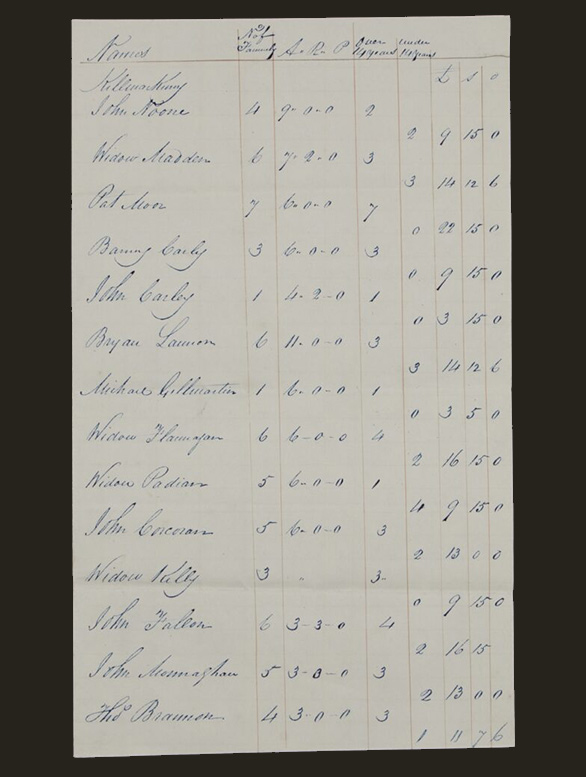

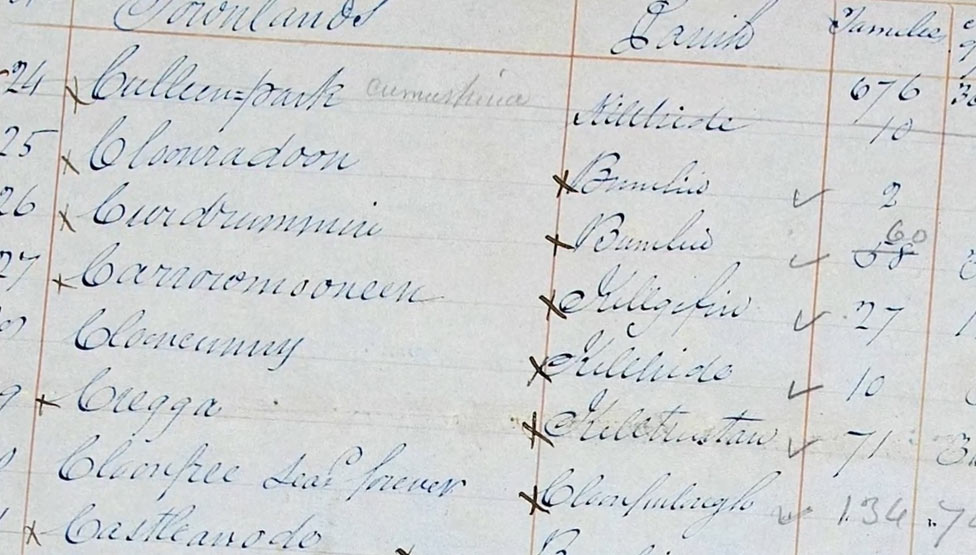
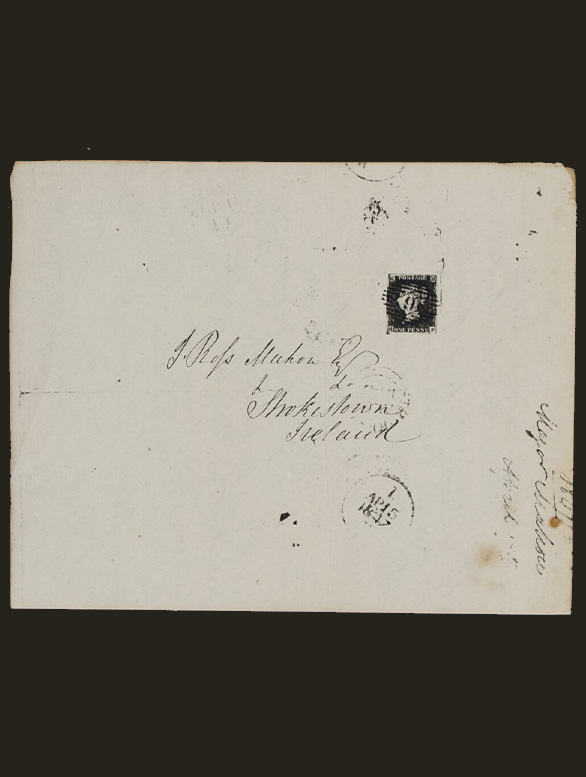
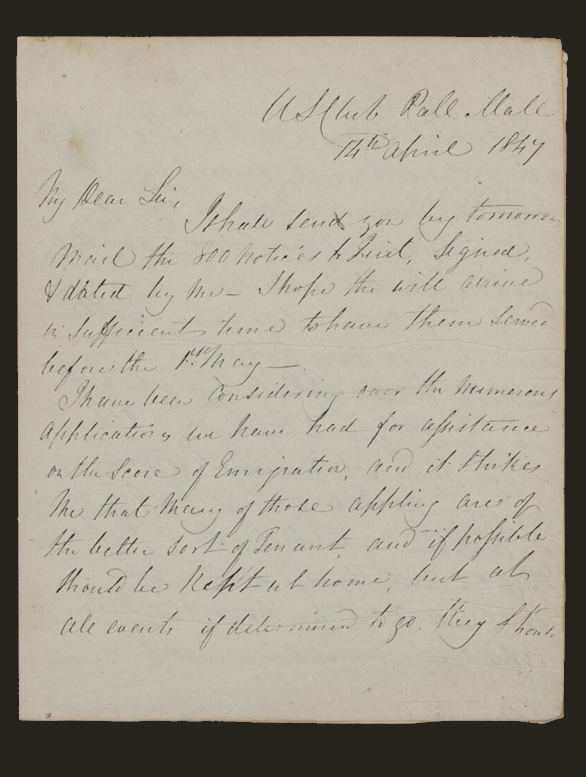
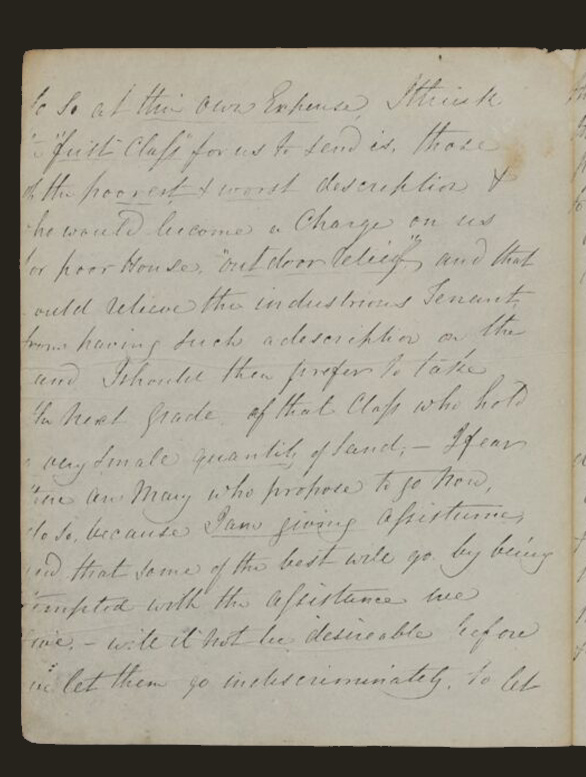
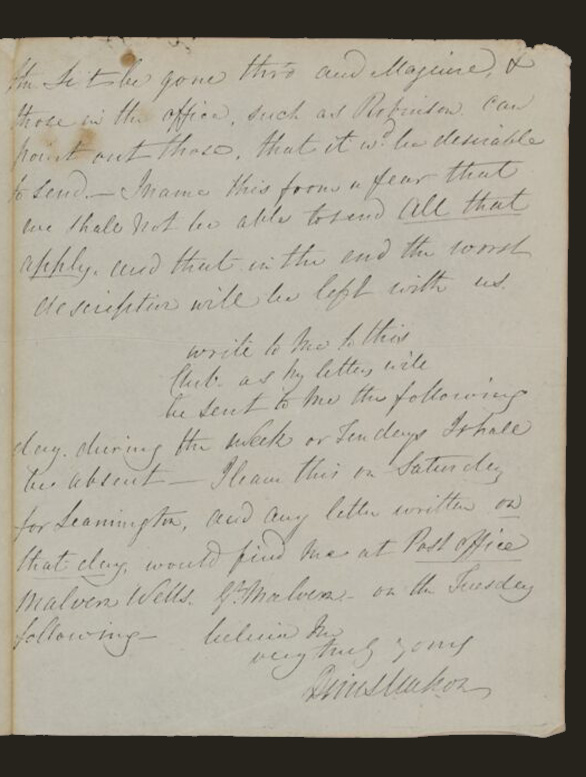
![The ‘Mem[orandum] of agreement of Tenants on Strokestown Estate’ on giving up possession of their holdings and becoming caretakers; witnessed by Michael Dalton, 14 May 1847’](https://strokestownpark.ie/wp-content/uploads/sites/2/2022/08/Memorandum-of-agreement-of-Tenants-on-Strokestown-Estate.jpg)
![The ‘Mem[orandum] of agreement of Tenants on Strokestown Estate’ on giving up possession of their holdings and becoming caretakers; witnessed by Michael Dalton, 14 May 1847’](https://strokestownpark.ie/wp-content/uploads/sites/2/2022/08/Memorandum-of-agreement-of-Tenants-on-Strokestown-Estate-2.jpg)
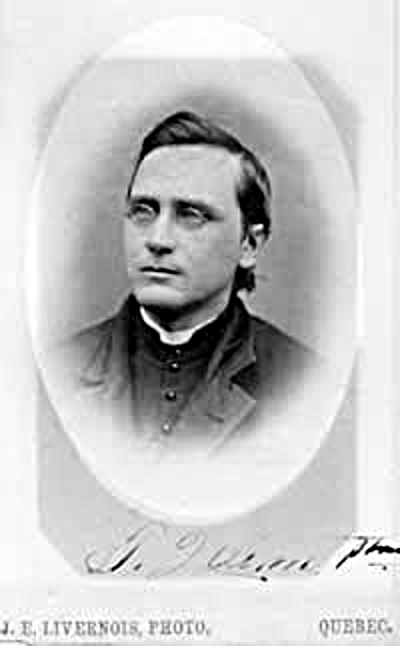
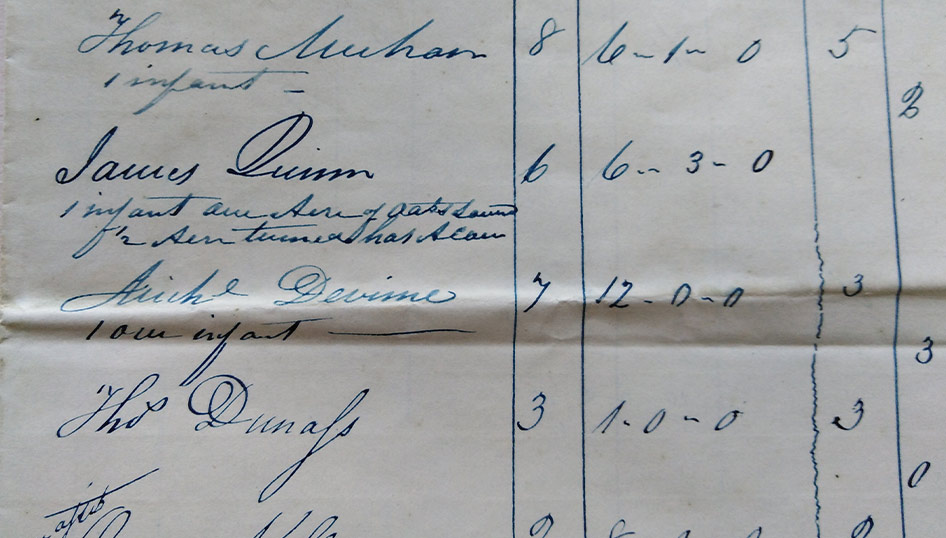

![STR/1A/168 Petition of evicted tenants of Ballinfad [1848], seeking compensation to allow them support themselves.](https://strokestownpark.ie/wp-content/uploads/sites/2/2022/08/Petition-of-evicted-tenants-of-Ballinfad-1.jpg)
![STR/1A/168 Petition of evicted tenants of Ballinfad [1848], seeking compensation to allow them support themselves.](https://strokestownpark.ie/wp-content/uploads/sites/2/2022/08/Petition-of-evicted-tenants-of-Ballinfad-2.jpg)
![STR/1A/168 Petition of evicted tenants of Ballinfad [1848], seeking compensation to allow them support themselves.](https://strokestownpark.ie/wp-content/uploads/sites/2/2022/08/Petition-of-evicted-tenants-of-Ballinfad-3.jpg)
![STR/1A/168 Petition of evicted tenants of Ballinfad [1848], seeking compensation to allow them support themselves.](https://strokestownpark.ie/wp-content/uploads/sites/2/2022/08/Petition-of-evicted-tenants-of-Ballinfad-4.jpg)
